Last updated: July 25, 2025
Article
View from the Aerie: Peregrine Falcon Watch in 2025
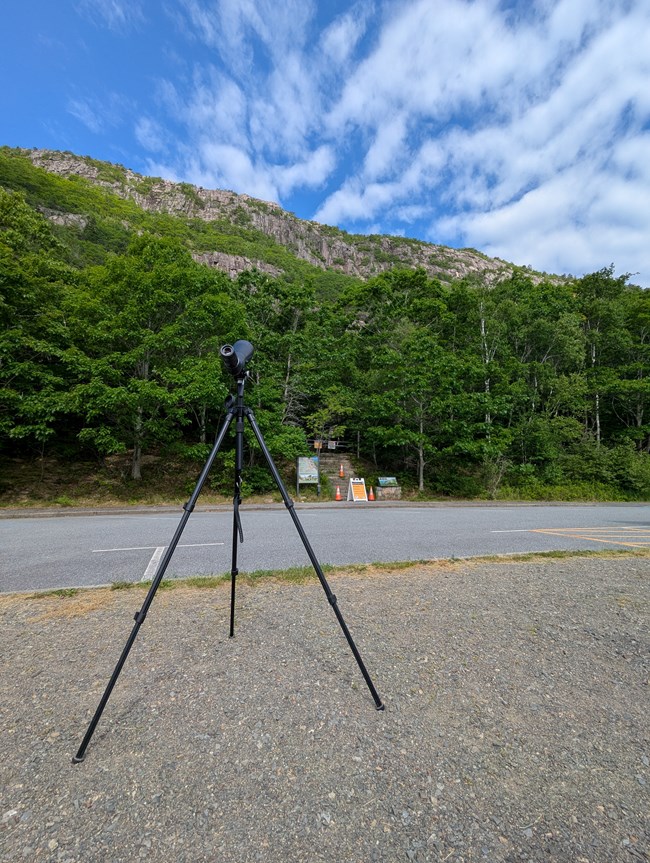
NPS Photo by Molly Mays
June 17th-20th
This week in Acadia marks the official beginning of summer, and with it comes the Peregrine Falcon Watch! Every year, breeding pairs of Peregrines swoop into the cliffs of Acadia to hatch and nurture their young. Right on cue this year, a pair of Peregrines claimed the Precipice Trail along the cliff face of Champlain Mountain to host their family. The pair has two chicks this year, right now around 32 days old. Because the falcons are so territorial, human disturbance can create stress for them and sometimes lead them to abandon their nests. To give these birds a better chance of success, trails near Peregrine nesting sites are closed annually until the chicks are fully independent of their parents. These trail closures include Valley Cove, Jordan Cliffs and Penobscot East Trail, and the home of the Peregrine Falcon Watch: Precipice Trail. Visitors can drop by the Precipice Trailhead parking lot for the Peregrine Falcon Watch Program every Monday-Friday from 9:00 AM-11:30 AM. With the help of park rangers and I, you’ll be able to see the chicks (eyases) growing up right on the cliffside. I’m Jazmine, a Student Conservation Association intern at Acadia and I’m thrilled to be your guide to the Peregrine Falcon Watch for the 2025 season.Acadia’s park rangers and biologists have been keeping an eye out for the Peregrines and their nesting habits since the middle of spring. So far, we’ve seen the birds putting on quite the show at Precipice! In the past month, the adult falcons have been keen to show off their speed as they glide along the cliff’s edge and over our heads. The ledge where they’ve been spending most of their time is their scrape; instead of building what we think of as a bird’s “nest”, Peregrine Falcons lay their eggs directly on rocky, elevated surfaces to get a good vantage point of prey and protection from predators. The two eyases in the scrape have the Peregrine parents on high alert right now. We’ve heard the territorial birds loudly chase off some feathered intruders (Turkey Vultures and Broad-Winged Hawks) each time they get too close for comfort.
For the past few days, the falcons have evaded being spotted with not even one glimpse of them in the scopes! The hot sun on Monday and rain on Tuesday may have had the falcons ducking for cover on the mountain. These hungry birds are also voracious predators that can fly up to 15 miles to catch their prey, so they could have been out hunting for their next meal. Hopefully the conditions will improve for the Peregrine Falcon Watch Program next week, and soon we’ll be ready for the eyases to begin putting on a show of their own!

NPS Photo by Olivia Hanson
June 23rd-28th
Excitement is building at the Peregrine Falcon Watch as the young falcons (eyases) prepare to fledge. Tensions are still high between other local birds of prey and the adult Peregrine Falcons. We witnessed a thrilling display of defense this week as the adult Peregrines dove through the air to strike an invading Broad-Winged Hawk, protecting their young. The mid-air battle between the Peregrine Falcons and the hawk lasted for a few minutes with the birds screeching and circling each other. Eventually, the Broad-Winged Hawk flew away in defeat and the Peregrine parents reclaimed their perches on the cliffside. The two eyases on Precipice Trail are estimated to be about 42 days old this week, so they were ready to begin making their first wobbly attempts at flying! At the beginning of the week, the juveniles stayed out of sight while we watched in anticipation. This Wednesday, one of the eyases was spotted flitting from ledge to ledge on Precipice. The first signs of flight from the juvenile were less than graceful, and the chick made several clumsy landings in the treetops. After the first sighting, we saw one of the juveniles testing out their wings at the program each day. The chick’s gawky flight pattern and dark brown chest markings helped us tell them apart from their parents.The adults were seen frequently coming and going from the cliff. To prepare the growing eyases for flight, the Peregrine parents spend much of the day hunting for food to bring back to the juveniles. Peregrine Falcons exclusively eat other birds and an adult needs to eat roughly the equivalent of one Blue-Jay every day. The eyases often eat even more food to give them the energy they need to grow and learn. Now that the juveniles are beginning to take flight, their parents will start offering them flying and hunting lessons as well. The juveniles will rely on their parents for food for another 20-40 days until they’re able to hunt successfully on their own.
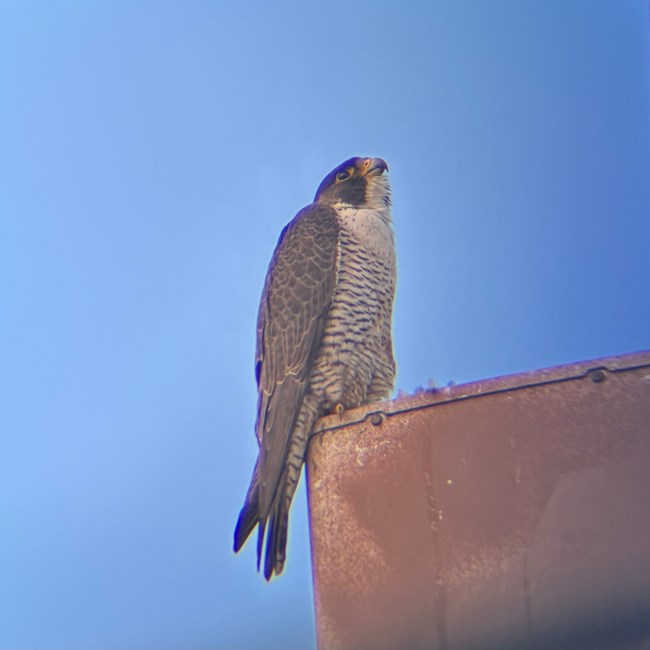
Photo by Jazmine DeBeauchamp
June 30th - July 4th
The juvenile Peregrine Falcons have been taking to the skies daily since their first flight. The siblings have been seen chasing each other through the air as a way of practicing their diving and prey-capture. They alternate between circling each other, colliding, and soaring side-by-side along the cliffs of Champlain. Their maneuvering seems to have improved since last week, but their landings are still a bit shaky. The fledglings also aren't quite ready to begin hunting for themselves. To hunt successfully, they'll need to continue working on strengthening their wings to support long-distance flights, and they'll need a bit more practice to perfect their stoop (diving after prey). This means the adult Peregrine Falcons are still responsible for bringing food back to the two fledglings to give them the best chance at reaching adulthood. Peregrines will fly up to 5-10miles to find food if needed. In fact, a Peregrine was even spotted feeding on a pigeon in downtown Bar Harbor! Although we were unable to confirm that this bird was one of the adults from the Precipice site, it is within their range. At the Peregrine Falcon Watch Program, we were able to see one of the parents exchange food with a fledgling. The adult flew in from the East, screeching, which alerted the juvenile of its return. The parent Peregrine Falcon then dropped a bird on a ledge, which the fledgling descended on to eat its meal. After eating, the juvenile bedded down in some grass and stared out over the ridge.On Tuesday afternoon, an adult Peregrine Falcon returned with a meal of its own. From the Precipice Lot, we could see feathers surrounding the Peregrine and red marks on its chest, likely remnants from its last meal. Afterwards, we were able to watch the adult preening itself and napping for nearly an hour. The adults will stay in the area for another month to keep supporting the juveniles as they gain independence. We’ll likely continue seeing all 4 of the Peregrine Falcons flying around the Precipice Trailhead lot for the rest of July!
Over the past few days, the Peregrines have shown that they can be voracious predators. Peregrine Falcons sit at the top of the food chain, which does have some perks; as adults, Peregrine Falcons don’t have to devote energy to evading predators. However, being a top predator can have its downsides, and the Peregrines have experienced them firsthand in the past. Because the Peregrines exclusively eat other birds, they consume any toxins that their prey have eaten, which can lead to a buildup of contaminants in their system. This is an effect called bioaccumulation. In the 1960s and 1970s, the widespread use of a pesticide called DDT led to a buildup of DDT in the tissues of the birds that Peregrine Falcons feed on. The DDT bioaccumulated at the top of the food chain as the Peregrines incidentally consumed increasing amounts of the pesticide. Unknowingly, this caused thinning in their eggs and a significant decline in nesting pairs of Peregrine Falcons in the U.S.
The nesting pairs we can see at the Precipice Trail and across Acadia National Park are here thanks to the continued restoration efforts of biologists since the 1970s. After the use of DDT was banned in the U.S., scientists began a process called hacking, where Peregrine Falcon chicks were captive-raised on cliffs to motivate them to return to the sites when they were ready to breed. In the mid-1980s, the first signs of success were observed on Jordan Cliffs when one of the captive-raised chicks returned to the site as a breeding adult. Since then, Acadia has been the breeding site for multiple pairs of Peregrine Falcons nearly every year!
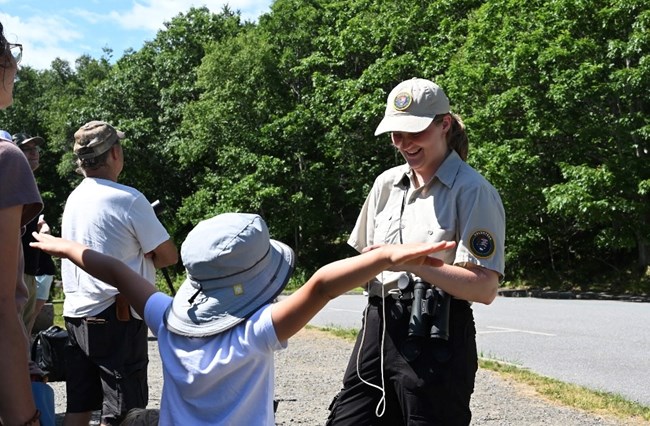
NPS Photo by Arturo Barrett
July 7th - 11th
The storms and hot sun kept the Peregrine Falcons ducking for cover and out of sight for much of the Peregrine Falcon Watch this week. When the Peregrines were visible, though, they were quite the spectacle. The fledglings have been getting lots of flying practice to prepare for their independence. One day this week, one of the parents flew in towards Champlain Mountain with a bird for the juveniles to eat. The adult, screeching to announce its return, prompted both of the juveniles to emerge from the cliffside and race for the meal. One fledgling reached the adult first, and they had a successful mid-air food exchange. The faster juvenile then sat on a ledge for about an hour, eating the bird while the unlucky sibling sat perched a few feet above the other, likely waiting for its own meal to arrive. Eventually, the hungry sibling seemed to grow weary of waiting for lunch and took off through the sky. After circling the cliff a few times, the hungry fledgling practiced a stoop over the parking lot. The fledgling dove from the top of the cliff towards us, and rose from the dive right above our heads. We were able to watch as the bird closed its wings against its body to dive faster and opened them to ascend or slow down.Peregrine Falcons can reach speeds of over 100 miles per hour when they’re diving. That kind of speed takes some practice to perfect, so it makes sense that the fledglings have been trying it out this week. Peregrines also use two different methods to stun and catch birds mid-air. The stoop, or dive, which we were lucky enough to see, is one way the Peregrines grab their prey from the skies. The other, more common way involves them using their feet to seize their prey mid-air. They lunge forward and use the strong tendons at the base of their feet to smack and stun the birds. The Peregrines then use their sharp talons to grab the disoriented birds to eat. Both of these methods require a lot of precision and control, which the juveniles are still working on improving.
The next day at the program, the two juveniles were getting some hunting practice together. They would zoom after one another and grab each other's tails or dive into one another as a way of rehearsing prey capture. Then, the juveniles would land together somewhere on the cliff, rest for a few moments, and take off through the sky to start the chase all over again. This went on for over an hour, and we could barely keep up with the fledglings in the viewing scopes as they darted through the clouds. It’s been very exciting to see the young Peregrine Falcons learn so much in the 2 short weeks since they fledged. I look forward to watching them continue to build their strength and skills toward self-sufficiency.

NPS Photo by Jazmine DeBeauchamp
July 14th - 17th
As the fledglings begin gearing up for independence and fall migration, they’re spending less and less time on the cliffs of Champlain Mountain. We’ve seen the young Peregrine Falcons flying for a few weeks now, which means their strength, agility, and precision have improved massively since their first precarious flights. The two juveniles are likely flying longer distances than before, and possibly even joining their parents as they hunt. The separation between the falcons and the cliff, combined with fog and heat, resulted in a minimal number of Peregrine sightings this week. It may be more likely to see the juveniles in other parts of Acadia as they explore beyond their nesting grounds. While the fledglings will become fully independent of their parents in late summer or early fall, we did still see one food exchange this week between an adult and a juvenile. That means the adults are still sticking around to watch over and support their offspring at this week. Interestingly, the juvenile and adult flew into the cliffside together, appearing to come from the same direction, before the adult handed off a new catch. Was the juvenile following the adult as it hunted, waiting for its parent to offer up a meal? After the swap, the adult took off and headed back the direction they came from. The fledgling landed on the cliffs, somewhere in the bushes, and ate its meal in hiding. The juvenile was likely eating out of sight intentionally, to guard its food from other birds, including its sibling.When they’re not actively breeding, Peregrine Falcons are solitary and aggressively defend their territory and resources. Now that they’re becoming less reliant on their parents for survival, the fledglings may begin to show aggression towards their family members. The juveniles may begin to pursue and sometimes attack their parents or siblings, especially when a potential meal is involved. These resource-guarding displays will get more intense as the young Peregrines become more confident and assertive. Much like the adults, when they were more fiercely protecting their more reliant eyases, we’ll even get the chance to see the juveniles chase off intruding birds. Even before becoming fully mature, the Peregrines will attack and defend themselves against much larger birds. Their ability to attack from above at very high speeds makes them an intimidating opponent, even for other fierce raptors!
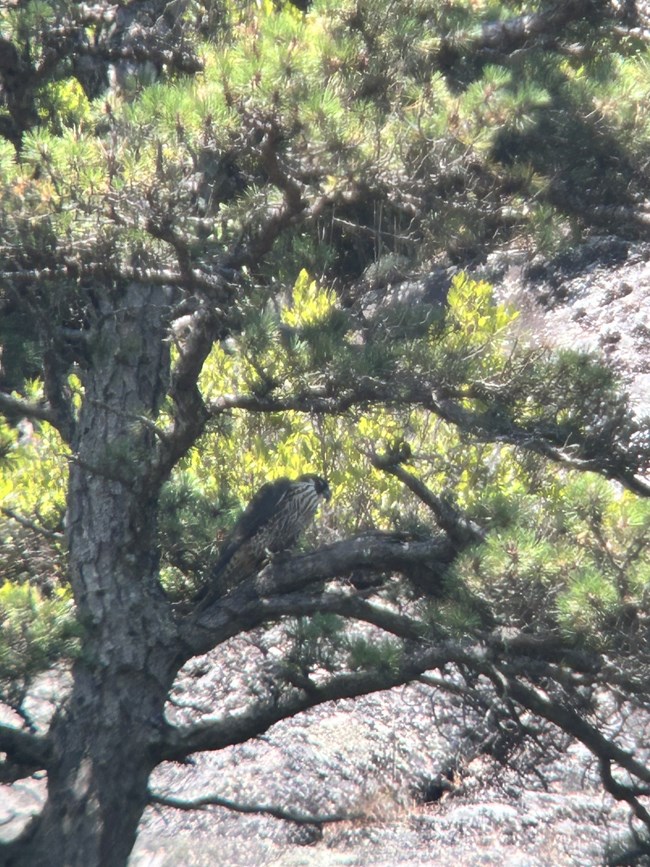
NPS Photo by Olivia Hanson
July 21st - 25th
The approaching end of July will usher in the departure of our juvenile and adult Peregrine Falcons. Adults typically leave when their offspring are no longer dependent on them, and juveniles leave shortly after to establish their wintering territories. While we don’t know exactly where this family of falcons will go in the fall, some of Acadia’s summer peregrines may go South for winter. Others could stay nearby at other spots in Maine and New England, dependent on weather and prey availability. Until then, the Peregrines are using Champlain as a home base for roosting, eating, and flying. At the beginning of this week, we spent hours watching the fledglings race through the skies. They seemed to be using the wind to their advantage; they moved the fastest I’ve seen yet as they practiced their dives! The siblings also showed off their agility when they soared towards each other and locked talons mid-air multiple times. Both fledglings can now skillfully aim, dive, and grab their intended target, so it seems all their flying practice is paying off. Through our binoculars, we were able to watch one of the juvenile Peregrines dive after a butterfly, catch it, and then rip it in half. The fledgling dropped the shredded butterfly without eating it, so it was strictly using the insect as target practice.Despite all of these newfound skills, the adult Peregrines have still been spotted giving the juveniles some assistance. The parents are occasionally bringing birds back to the Precipice Trail to feed the fledglings, and on Tuesday, both fledglings were lucky enough to be brought a meal. From the Precipice Trailhead parking lot, we could see that one of the juveniles was bigger than the adult! Peregrine Falcons exhibit reversed sexual dimorphism, meaning that females are approximately ⅓ larger than males. Their size difference leads us to believe that the parent Peregrine we saw on Tuesday was likely a male, and the larger fledgling is a female!
On the last day of the Peregrine Falcon Watch, rangers saw one of the fledglings come back to the cliffs of Champlain Mountain with a bird in its talons! The young Peregrine perched on a ledge to dig into its meal, and visitors watched through the scopes as it plucked the bird apart. For the rest of the program, the fledgling napped and preened itself on the rocks, temporarily satisfied with its lunch. Later, the other juvenile and one of the adults soared over the parking lot, pursuing each other and locking talons again!
Unfortunately, all this excitement can’t last forever. All the progress the juveniles have made means that we’ll soon have to say goodbye to the Peregrine Falcons for this season. I’ll certainly miss seeing these beautiful birds, but I’m also elated they’ve had such a successful summer. Though the 2025 Peregrine Falcon Watch program will be coming to a close soon, Acadia is a great spot for birding year-round.
When our breeding population does move on, we’ll begin seeing Peregrine populations from Greenland and Canada fly through Maine as they migrate South. You can join me in the fall at the Hawk Watch Program to witness dozens of falcons and other raptors fly over Cadillac Mountain on their migration journey. Follow along on the Acadia National Park website as I post Hawk Watch updates throughout the season!
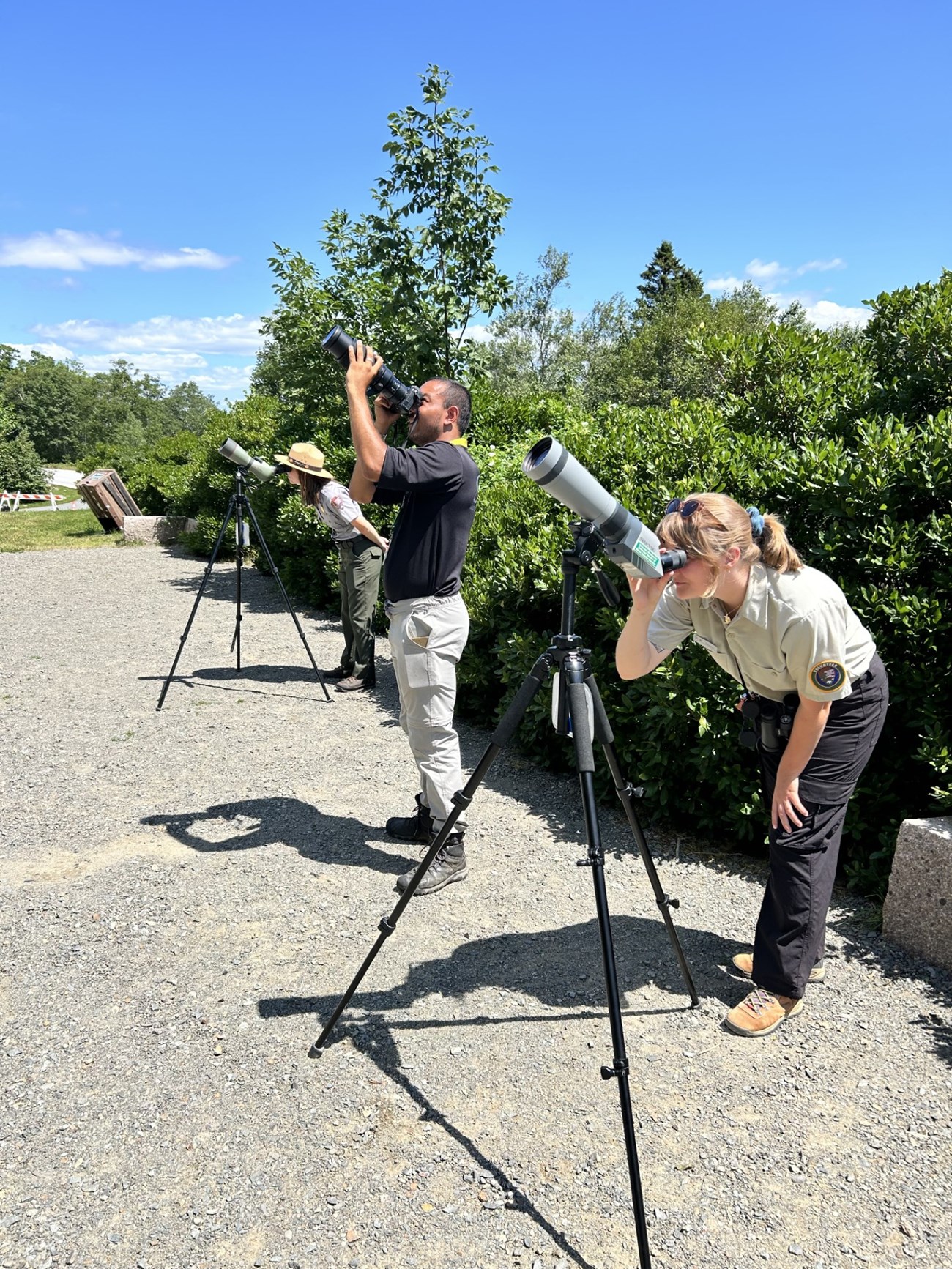
NPS Photo by Olivia Hanson
